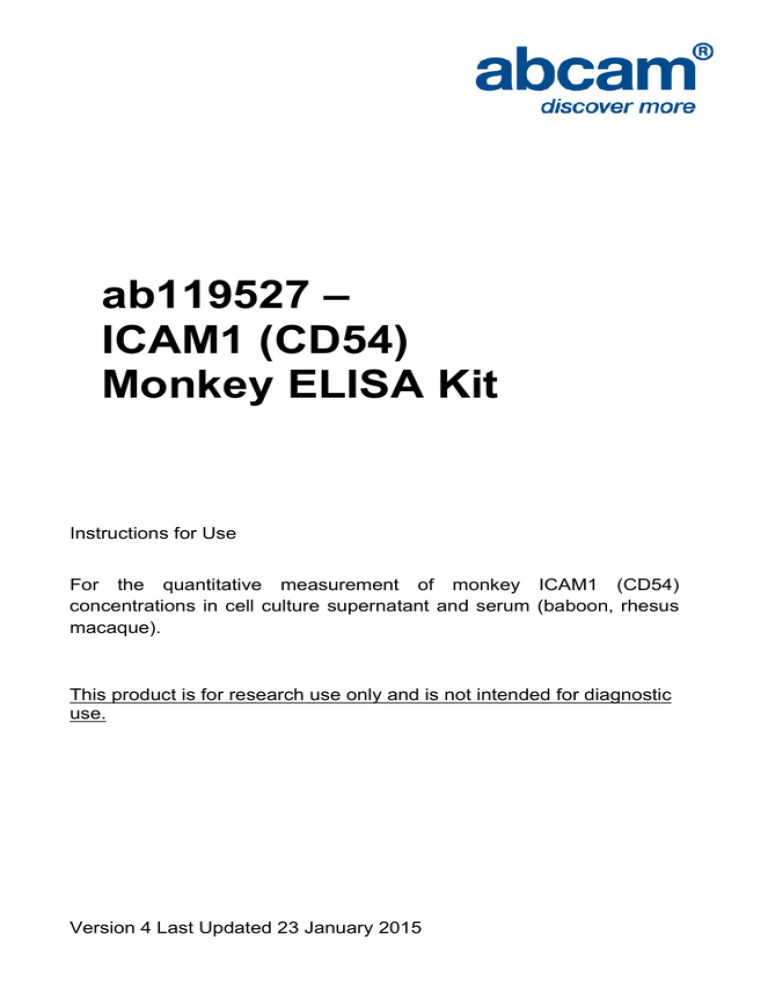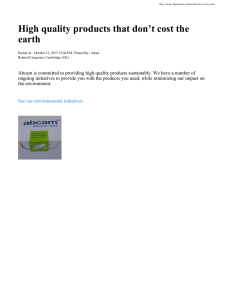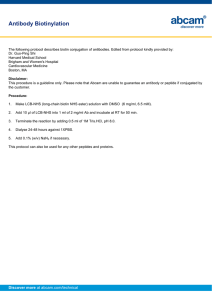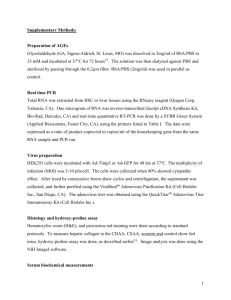
ab119527 –
ICAM1 (CD54)
Monkey ELISA Kit
Instructions for Use
For the quantitative measurement of monkey ICAM1 (CD54)
concentrations in cell culture supernatant and serum (baboon, rhesus
macaque).
This product is for research use only and is not intended for diagnostic
use.
Version 4 Last Updated 23 January 2015
Table of Contents
INTRODUCTION
1.
BACKGROUND
2.
ASSAY SUMMARY
2
4
GENERAL INFORMATION
3.
PRECAUTIONS
4.
STORAGE AND STABILITY
5.
MATERIALS SUPPLIED
6.
MATERIALS REQUIRED, NOT SUPPLIED
7.
LIMITATIONS
8.
TECHNICAL HINTS
5
5
5
6
6
7
ASSAY PREPARATION
9.
REAGENT PREPARATION
10. STANDARD PREPARATIONS
11. SAMPLE COLLECTION AND STORAGE
12. PLATE PREPARATION
8
10
11
12
ASSAY PROCEDURE
13. ASSAY PROCEDURE
13
DATA ANALYSIS
14. CALCULATIONS
15. TYPICAL DATA
16. TYPICAL SAMPLE VALUES
17. ASSAY SPECIFICITY
15
16
17
17
RESOURCES
18. TROUBLESHOOTING
19. NOTES
18
19
Discover more at www.abcam.com
1
INTRODUCTION
1. BACKGROUND
Abcam’s ICAM1 (CD54) Monkey in vitro ELISA (Enzyme-Linked
Immunosorbent Assay) kit is designed for accurate quantitative
measurement of monkey ICAM1 (CD54) concentrations in cell culture
supernatant and serum (baboon, rhesus macaque).
ICAM1 specific antibodies have been precoated onto 96-well plates.
Standards and test samples are added to the wells and along with an
HRP-conjugated ICAM1 detection antibody and the microplate is then
incubated at room temperature. After the removal of unbound proteins
by washing, TMB is added and catalyzed by HRP to produce a blue
color product that changes into yellow after addition of an acidic stop
solution. The density of yellow coloration is directly proportional to the
amount ICAM1 captured on the plate.
Intercellular Adhesion Molecule-1 (ICAM1,) is a member of the
immunoglobulin supergene family and functions as a ligand for the
Lymphocyte Function-Associated Antigen-1 (LFA-1), an alpha-betacomplex that is a member of the leukocyte integrin family of cell-cell
and cell-matrix receptors. This family consists of the leukocyte
adhesion glycoproteins LFA-1 which mediates lymphocyte adhesion,
Mac-1 which mediates granulocyte adhesion and p150,95.
ICAM1 is a single-chain glycoprotein with a polypeptide core of 55kD
that can be expressed on non-hematopoietic cells of many lineages
such as vascular endothelial cells, thymic epithelial cells, other
epithelial cells and fibroblasts and on hematopoietic cells such as
tissue macrophages, mitogen-stimulated T-lymphoblasts, germinal
center B-cells and dendritic cells in tonsils, lymph nodes and Peyer's
patches. ICAM1 is inducible on fibroblasts and endothelial cells by
inflammatory mediators such as IL-1, TNF and IFN within few hours
and is correlated to the infiltration of lymphocytes into inflammatory
lesions. ICAM1 seems to be the initial marker of inflammatory
Discover more at www.abcam.com
2
INTRODUCTION
reactions and is expressed prior to, and to a greater extent than is
HLA-DR.
The role of ICAM1 as a disease marker has been demonstrated for a
number of different indications and pathological situations.
Discover more at www.abcam.com
3
INTRODUCTION
2. ASSAY SUMMARY
Remove appropriate number of
antibody coated well strips.
Equilibrate all reagents to room
temperature. Prepare all the reagents,
samples, and standards as instructed.
Add standard or sample to each well.
Add prepared HRP labeled secondary
detector antibody. Incubate wells.
Aspirate and wash each well. Add
TMB Solution to each well. Incubate
before adding stop solution and
reading plate immediately.
Discover more at www.abcam.com
4
GENERAL INFORMATION
3. PRECAUTIONS
Please read these instructions carefully prior to beginning the
assay.
All kit components have been formulated and quality control tested to
function successfully as a kit. Modifications to the kit components or
procedures may result in loss of performance.
4. STORAGE AND STABILITY
Upon receipt, store kit immediately at 2-8ºC.
Refer to list of materials supplied for storage conditions of individual
components. Observe the storage conditions for individual prepared
components in section 9 Reagent Preparation.
5. MATERIALS SUPPLIED
Amount
Storage
Condition
(Before
Preparation)
96 wells
2-8 ºC
100 µL
2-8 ºC
2 Vials
2-8 ºC
Sample Diluent
12 mL
2-8 ºC
20X Assay Buffer Concentrate
5 mL
2-8 ºC
20X Wash Buffer Concentrate
50 mL
2-8 ºC
TMB Substrate Solution
15 mL
2-8 ºC
Stop Solution (1M Phosphoric acid)
15 mL
2-8 ºC
Item
Microplate coated with monoclonal antibody to
ICAM1 (12 x 8 wells)
HRP Conjugated anti- ICAM1 monoclonal
antibody
ICAM1 Standard (100 U/mL)
Discover more at www.abcam.com
5
GENERAL INFORMATION
6. MATERIALS REQUIRED, NOT SUPPLIED
These materials are not included in the kit, but will be required to
successfully utilize this assay:
5 mL and 10 mL graduated pipettes
5 µL to 1000 µL adjustable single channel micropipettes with
disposable tips
50 µL to 300 µL adjustable multichannel micropipette with
disposable tips
Multichannel micropipette reservoir
Beakers, flasks, cylinders necessary for preparation of reagents
Device for delivery of wash solution (multichannel wash bottle or
automatic wash system)
Microplate strip reader capable of reading at 450 nm (620 nm as
optional reference wave length)
Glass-distilled or deionized water
Statistical calculator with program to perform regression analysis
7. LIMITATIONS
Assay kit intended for research use only. Not for use in diagnostic
procedures
Do not use kit or components if it has exceeded the expiration date
on the kit labels
Do not mix or substitute reagents or materials from other kit lots or
vendors. Kits are QC tested as a set of components and
performance cannot be guaranteed if utilized separately or
substituted
Discover more at www.abcam.com
6
GENERAL INFORMATION
8. TECHNICAL HINTS
Samples generating values higher than the highest standard
should be further diluted in the appropriate sample assay buffers
Avoid foaming
components
Avoid cross contamination of samples or reagents by changing tips
between sample, standard and reagent additions.
Ensure plates are properly sealed or covered during incubation
steps
Complete removal of all solutions and buffers during wash steps.
As exact conditions may vary from assay to assay, a standard
curve must be established for every run.
Disposable pipette tips, flasks or glassware are preferred, reusable
glassware must be washed and thoroughly rinsed of all detergents
before use.
Improper or insufficient washing at any stage of the procedure will
result in either false positive or false negative results. Empty wells
completely before dispensing fresh wash solution, fill with Wash
Buffer as indicated for each wash cycle and do not allow wells to
sit uncovered or dry for extended periods.
The use of radio immunotherapy has significantly increased the
number of patients with monkey anti-mouse IgG antibodies
(HAMA). HAMA may interfere with assays utilizing murine
monoclonal antibodies leading to both false positive and false
negative results. Serum samples containing antibodies to murine
immunoglobulins can still be analyzed in such assays when murine
immunoglobulins (serum, ascitic fluid, or monoclonal antibodies of
irrelevant specificity) are added to the sample.
This kit is sold based on number of tests. A ‘test’ simply refers
to a single assay well. The number of wells that contain sample,
control or standard will vary by product. Review the protocol
completely to confirm this kit meets your requirements. Please
contact our Technical Support staff with any questions
or
bubbles
Discover more at www.abcam.com
when
mixing
or
reconstituting
7
ASSAY PREPARATION
9. REAGENT PREPARATION
Equilibrate all reagents and samples to room temperature (18-25°C)
prior to use.
9.1
1X Wash Buffer
Prepare 1X Wash Buffer by diluting the 20X Wash Buffer
Concentrate with distilled or deionized water. To make
500 mL 1X Wash Buffer, combine 25 mL 20X Wash Buffer
Concentrate with 475 mL distilled or deionized water. Mix
thoroughly and gently to avoid foaming.
Note: The 1X Wash Buffer should be stored at 2-8 ºC and is
stable for 30 days.
9.2
1X Assay Buffer
Prepare 1X Assay Buffer by diluting the 20X Assay Buffer
Concentrate with distilled or deionized water. To make
50 mL 1X Assay Buffer, combine 2.5 mL 20X Assay Buffer
Concentrate with 47.5 mL distilled or deionized water. Mix
thoroughly and gently to avoid foaming.
Note: The 1X Assay Buffer should be stored at 2-8 ºC and is
stable for 30 days.
Discover more at www.abcam.com
8
ASSAY PREPARATION
9.3
1X HRP Conjugated Antibody
To prepare the Biotin-Conjugate, dilute the HRP-conjugated
anti-monkey ICAM1 monoclonal antibody 100-fold with 1X
Assay buffer. Use the following table to prepare as much
HRP-Conjugate as needed by adding the required volume
(µL) of the HRP Conjugated Antibody to the required volume
(mL) of 1X Assay Buffer. Mix gently and thoroughly.
Number of
strips
1-6
7 - 12
Volume of BiotinConjugate anti-monkey
ICAM1 antibody
(µL)
30
60
Volume of 1X Assay
buffer
(mL)
2.97
5.94
Note: The 1X HRP-Conjugated Antibody should be used
within 30 minutes after dilution.
Discover more at www.abcam.com
9
ASSAY PREPARATION
10. STANDARD PREPARATIONS
Prepare serially diluted standards immediately prior to use. Always
prepare a fresh set of standards for every use.
10.1 Label six tubes with numbers 1 - 6.
10.2 Add 225 µL of the ICAM1 Standard (100 U/mL) to tube 1.
10.3 Add 225 µL Sample Diluent to all remaining tubes.
10.4 Prepare a 50 U/mL Standard 2 by transferring 225 µL from
Standard 1 to tube 2. Mix thoroughly and gently.
10.5 Prepare Standard 3 by transferring 225 µL from Standard 2
to tube 3. Mix thoroughly and gently.
10.6 Using the table below as a guide, repeat for tubes number 4
and 5.
10.7 Standard 6 contains no protein and is the Blank control.
Standard
1
2
3
4
5
6
Volume
Volume of
Starting
to
Diluent
Conc.
Dilute
(µL)
(U/mL)
(µL)
ICAM1 Standard (100 U/mL)
Standard 1
225
225
100
Standard 2
225
225
50
Standard 3
225
225
25
Standard 4
225
225
12.5
None
225
Sample to
Dilute
Discover more at www.abcam.com
Final
Conc.
(U/mL)
100
50
25
12.5
6.3
0
10
ASSAY PREPARATION
11. SAMPLE COLLECTION AND STORAGE
Cell culture supernatant and serum (baboon, rhesus macaque)
were tested with this assay. Other biological samples might be
suitable for use in the assay. Remove serum from the clot as soon
as possible after clotting
Possible “Hook Effects” may be observed due to high sample
concentrations. It is recommended to run several dilutions of your
sample to ensure an accurate reading
Samples containing a visible precipitate must be clarified prior to
use in the assay. Do not use grossly hemolyzed or lipemic
specimens
Samples should be aliquoted and must be stored frozen at -20°C
to avoid loss of bioactive monkey ICAM1. If samples are to be run
within 24 hours, they may be stored at 2° to 8°C
Avoid repeated freeze-thaw cycles. Prior to assay, the frozen
sample should be brought to room temperature slowly and mixed
gently
Aliquots of serum samples (spiked or unspiked) were stored at 20°C and thawed 5 times, and the monkey ICAM1 levels
determined. There was no significant loss of monkey ICAM1
immunoreactivity detected by freezing and thawing
Cell culture media without serum component are not suitable for
monkey ICAM1 determination with the ELISA
Discover more at www.abcam.com
11
ASSAY PREPARATION
Aliquots of serum samples (spiked or unspiked) were stored at 20°C, 2-8°C, room temperature (RT) and at 37°C, and the monkey
ICAM1 level determined after 24, 48 and 96 h. There was no
significant loss of monkey ICAM1 immunoreactivity detected
during storage under above conditions
12. PLATE PREPARATION
The 96 well plate strips included with this kit are supplied ready to
use
Unused well strips should be returned to the plate packet and
stored at 2-8°C
For each assay performed, a minimum of 2 wells must be used as
blanks
For statistical reasons, we recommend each sample should be
assayed with a minimum of two replicates (duplicates)
Well effects have not been observed with this assay
Discover more at www.abcam.com
12
ASSAY PROCEDURE
13. ASSAY PROCEDURE
Equilibrate all materials and prepared reagents to room
temperature prior to use.
It is recommended to assay all standards, controls and
samples in duplicate.
13.1. Prepare all reagents, working standards, and samples as
directed in the previous sections. Determine the number of
microplate strips required to test the desired number of
samples plus appropriate number of wells needed for
running blanks and standards.
13.2. Wash the microplate twice with approximately 400 µL
1X Wash Buffer per well with thorough aspiration of
microplate contents between washes. Allow the 1X Wash
Buffer to remain in the wells for about 10 - 15 seconds
before aspiration. Take care not to scratch the surface of
the microplate.
13.3. After the last wash step, empty wells and tap microplate on
absorbent pad or paper towel to remove excess 1X Wash
Buffer. Use the microplate strips immediately after washing.
Alternatively the microplate strips can be placed upside
down on a wet absorbent paper for not longer than
15 minutes. Do not allow wells to dry.
13.4. Add 100 µL of Standards to the appropriate wells, including
the no protein control.
13.5. Add 90 µL of Sample Diluent to the sample wells.
13.6. Add 10 µL of each sample to appropriate wells.
13.7. Add 50 µL of 1X HRP Conjugated Antibody to all wells.
13.8. Cover with adhesive film and incubate at room temperature
(18° to 25°C) for 1 hour (microplate can be incubated on a
shaker set at 400 rpm).
13.9. Remove adhesive film and empty wells. Wash microplate
strips 3 times according to step 13.2. Proceed immediately
to step 13.10.
Discover more at www.abcam.com
13
ASSAY PROCEDURE
13.10. Pipette 100 µL of TMB Substrate Solution to all wells.
13.11. Incubate the microplate strips at room temperature
(18 to 25°C) for 10 minutes. Avoid direct exposure to
intense light.
Note: The color development on the plate should be
monitored and the substrate reaction stopped (see step
13.12) before the signal in the positive wells becomes
saturated. Determination of the ideal time period for color
development should to be done individually for each assay.
It is recommended to add the stop solution when the
highest standard has developed a dark blue color.
Alternatively the color development can be monitored by
the ELISA reader at 620 nm. The substrate reaction should
be stopped as soon as Standard 1 has reached an OD of
0.9 - 0.95.
13.12. Stop the enzyme reaction by adding 100 µL of Stop
Solution into each well.
Note: It is important that the Stop Solution is mixed quickly
and uniformly throughout the microplate to completely
inactivate the enzyme. Results must be read immediately
after the Stop Solution is added or within one hour if the
microplate strips are stored at 2 - 8°C in the dark.
13.13. Read
absorbance
of
each
microplate
on
a
spectrophotometer using 450 nm as the primary wave
length (optionally 620 nm as the reference wave length;
610 nm to 650 nm is acceptable). Blank the plate reader
according to the manufacturer's instructions by using the
blank wells. Determine the absorbance of both the samples
and the standards.
Note: In case of incubation without shaking the obtained O.D.
values may be lower than indicated below. Nevertheless the
results are still valid.
Discover more at www.abcam.com
14
DATA ANALYSIS
14. CALCULATIONS
Average the duplicate reading for each standard, sample and control
blank. Subtract the control blank from all mean readings. Plot the mean
standard readings against their concentrations and draw the best
smooth curve through these points to construct a standard curve.
Most plate reader software or graphing software can plot these values
and curve fit. A four parameter algorithm (4PL) usually provides the
best fit, though other equations can be examined to see which
provides the most accurate (e.g. linear, semi-log, log/log, 4-parameter
logistic). Extrapolate protein concentrations for unknown and control
samples from the standard curve plotted. Samples producing signals
greater than that of the highest standard should be further diluted in
appropriate buffer and reanalyzed, then multiplying the concentration
found by the appropriate dilution factor.
If samples have been diluted 1:10, as stated in step 13.6, the
concentration obtained from the standard curve must be multiplied by
the dilution factor (x 10) to obtain an accurate value. This is in addition
to any sample dilution undertaken by the user.
Calculation of samples with a concentration exceeding standard 1 will
result in incorrect, low monkey ICAM1 levels (Hook Effect). Such
samples require further external predilution according to expected
monkey ICAM1 values with Sample Diluent in order to precisely
quantitate the actual monkey ICAM1 level.
Discover more at www.abcam.com
15
DATA ANALYSIS
15. TYPICAL DATA
TYPICAL STANDARD CURVE – Data provided for demonstration
purposes only. A new standard curve must be generated for each
assay performed.
Standard Curve Measurements
Conc.
O.D. 450 nm
Mean
(U/mL)
1
2
O.D.
0.0
0.011
0.013
0.012
6.3
0.204
0.177
0.191
12.5
0.374
0.354
0.364
25.0
0.918
0.841
0.880
50.0
1.747
1.596
1.672
100.0
2.773
2.649
2.771
Figure 1. Example of monkey ICAM1 protein standard curve.
Discover more at www.abcam.com
16
DATA ANALYSIS
16. TYPICAL SAMPLE VALUES
SENSITIVITY The limit of detection of monkey ICAM1 defined as the analyte
concentration resulting in an absorbance significantly higher than that
of the dilution medium (mean plus 2 standard deviations) was
determined to be 1.1 U/mL (mean of 6 independent assays).
RECOVERY –
The spike recovery was evaluated by spiking 4 levels of monkey
ICAM1 into Sample Diluent (serum matrix). Recoveries were
determined in 3 independent experiments with 4 replicates each.
The overall mean recovery was 95%.
LINEARITY OF DILUTION –
4 serum samples with different levels of monkey ICAM1 were analyzed
at serial 2 fold dilutions with 4 replicates each.
The overall mean recovery was 106%.
PRECISION –
Intra- and Inter-assay reproducibility was determined by measuring
samples containing different concentrations of monkey ICAM1.
n=
%CV
Intra-Assay
6
<5
Inter-Assay
6
<10
17. ASSAY SPECIFICITY
The interference of circulating factors of the immune system was
evaluated by spiking these proteins at physiologically relevant
concentrations into a monkey ICAM1 positive serum. There was no
cross reactivity detected.
Discover more at www.abcam.com
17
RESOURCES
18. TROUBLESHOOTING
Problem
Poor
standard
curve
Low Signal
Samples
give higher
value than
the highest
standard
Cause
Solution
Inaccurate pipetting
Check pipettes
Improper standards
dilution
Prior to opening, briefly spin the
stock standard tube and dissolve
the powder thoroughly by gentle
mixing
Incubation times too
brief
Ensure sufficient incubation times;
change to overnight
standard/sample incubation
Inadequate reagent
volumes or improper
dilution
Check pipettes and ensure correct
preparation
Starting sample
concentration is too
high.
Dilute the specimens and repeat
the assay
Plate is insufficiently
washed
Review manual for proper wash
technique. If using a plate washer,
check all ports for obstructions
Contaminated wash
buffer
Prepare fresh wash buffer
Improper storage of
the kit
Store the all components as
directed.
Large CV
Low
sensitivity
Discover more at www.abcam.com
18
RESOURCES
19. NOTES
Discover more at www.abcam.com
19
RESOURCES
Discover more at www.abcam.com
20
RESOURCES
Discover more at www.abcam.com
21
RESOURCES
Discover more at www.abcam.com
22
UK, EU and ROW
Email: technical@abcam.com | Tel: +44-(0)1223-696000
Austria
Email: wissenschaftlicherdienst@abcam.com | Tel: 019-288-259
France
Email: supportscientifique@abcam.com | Tel: 01-46-94-62-96
Germany
Email: wissenschaftlicherdienst@abcam.com | Tel: 030-896-779-154
Spain
Email: soportecientifico@abcam.com | Tel: 911-146-554
Switzerland
Email: technical@abcam.com
Tel (Deutsch): 0435-016-424 | Tel (Français): 0615-000-530
US and Latin America
Email: us.technical@abcam.com | Tel: 888-77-ABCAM (22226)
Canada
Email: ca.technical@abcam.com | Tel: 877-749-8807
China and Asia Pacific
Email: hk.technical@abcam.com | Tel: 108008523689 (中國聯通)
Japan
Email: technical@abcam.co.jp | Tel: +81-(0)3-6231-0940
www.abcam.com | www.abcam.cn | www.abcam.co.jp
Copyright © 2015 Abcam, All Rights Reserved. The Abcam logo is a registered trademark.
All
information / detail is correct at time of going to print.
RESOURCES
23




![Anti-DR4 antibody [B-N28] ab59481 Product datasheet Overview Product name](http://s2.studylib.net/store/data/012243732_1-814f8e7937583497bf6c17c5045207f8-300x300.png)
![Anti-FAT antibody [Fat1-3D7/1] ab14381 Product datasheet Overview Product name](http://s2.studylib.net/store/data/012096519_1-dc4c5ceaa7bf942624e70004842e84cc-300x300.png)